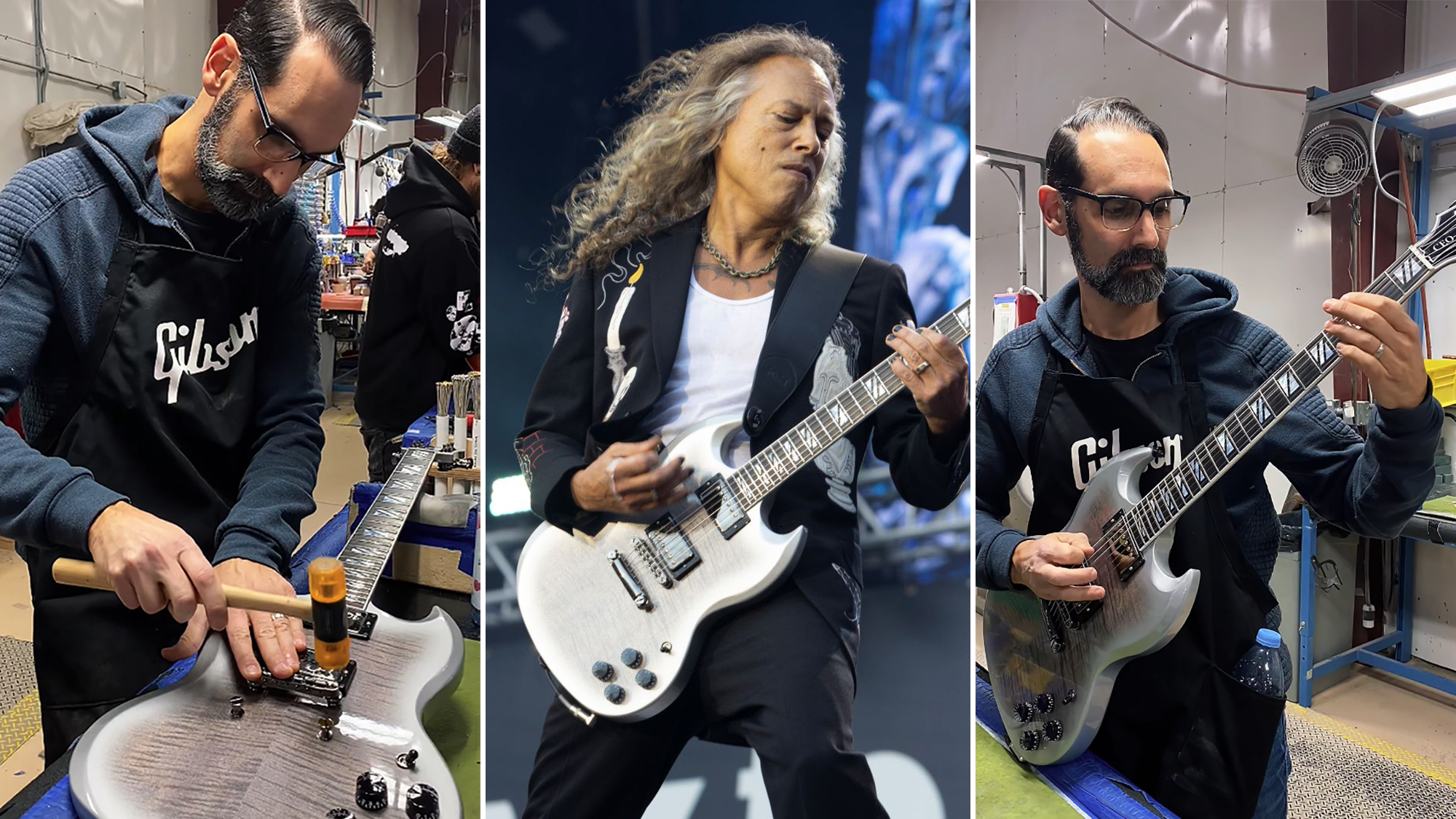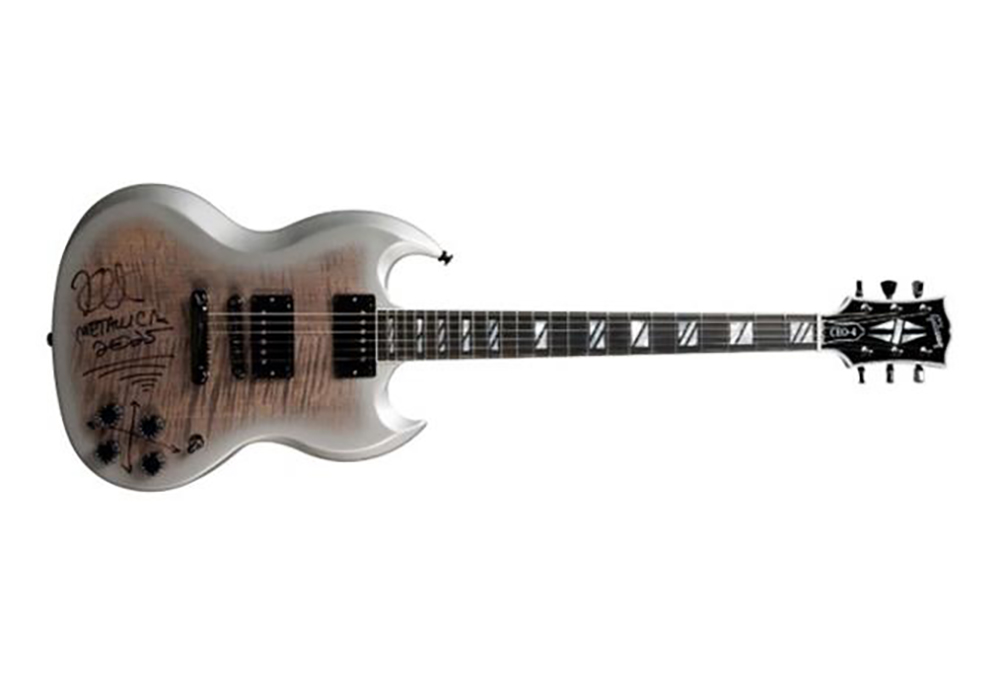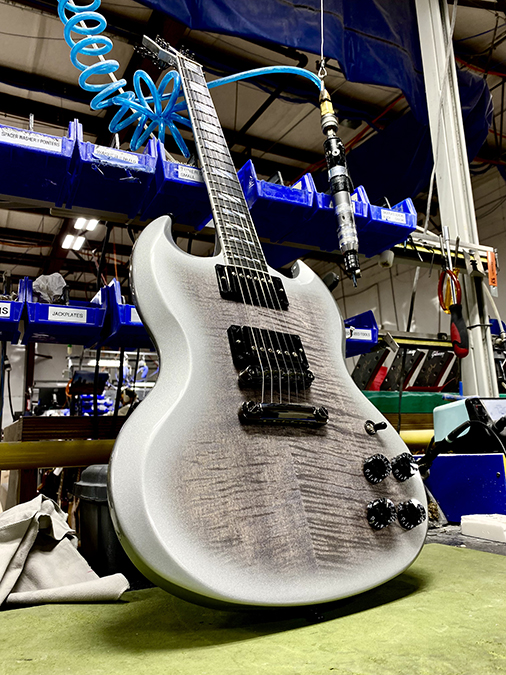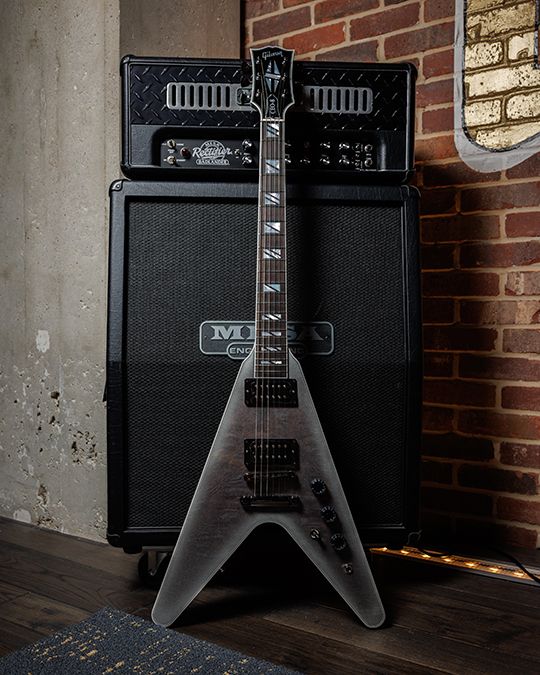“When I finished, I sent Kirk Hammett a picture and said, ‘Do you want to use it?’ He replied in all caps, ‘YES!’” Gibson CEO Cesar Gueikian has spent 4 years learning how to build guitars – and his prized SG was played at metal’s most historic concert

As the CEO of one of the world’s most important guitar brands, Gibson’s Cesar Gueikian has a pretty full plate.
Between developing new models, paying homage to Gibson’s heritage, bringing back long-lost designs, teasing upcoming launches on social media, expanding the company’s physical presence through various Garage stores and more, you’d be forgiven for thinking that Gueikian would struggle to find time to squeeze a new hobby into his hectic schedule.
But that’s not the case. While spinning the many plates that come with the job of Gibson CEO, Gueikian has also committed considerable time to learning the meticulous art of guitar making.
He has, for the past four years, been honing his skills as a luthier, gaining exposure and improving his understanding of each step of the process, from spec sheet to shred ready.
These are no novelty instruments, though. Rather, they are an collection of unique high-end electric guitars borne out of Gueikian’s passion for Gibson guitars and desire to inject them with something different. Something, in his own words, “epic”.
Gueikian charts all of his builds on his Instagram, and they’ve been gaining some traction. Hollywood star Jason Momoa – or, more specifically, Momoa’s son – is the proud owner of CEO-2, a decidedly James Hetfield-esque Explorer.
There’s also the CEO-1 – a Les Paul whose creation was documented via a social media series – and the Victory-styled CEO-3.
All the latest guitar news, interviews, lessons, reviews, deals and more, direct to your inbox!
The most notable CEO model, though, is the CEO-4 – a Ghost Burst SG that Gueikian built and gave to Kirk Hammett, who played it at Ozzy Osbourne and Black Sabbath’s final show, Back to the Beginning, for Metallica’s cover of Hole in the Sky.
That custom double-cut – which was named by Adam Jones, admired by Tony Iommi, and played by the Metallica great – is one of Gueikian’s most prized creations to date, and recently sold for $76,800 at auction in support of the Gibson Gives foundation.
We caught up with Gueikian before the auction to find out more about his guitar-making journey to date, and how the CEO-4 ended up playing a starring role at one of metal music’s most historic events.

How did the CEO series start for you? What inspired you to get into guitar building?
It started with an interest in building a guitar from beginning to end, and that changed over time. My initial thought was, ‘How interesting would it be to build a guitar from beginning to end, and learn the process of doing that?’
That's been really one of the most enjoyable moments for me in my Gibson career. I get to work, and I get to learn from our people, and that's been amazing
That was the first one. It took me three months, because I was going to the craftories for a few hours every Friday morning. Once I finished it, I realized it wasn't about the guitar. It was about the process of learning and working with our people, getting them to teach me how to do something.
I really enjoyed the whole process of getting to know them better, getting to learn from them, and that's what triggered in my mind, ‘This is something that I want to keep doing.’ Not only that, there's an opportunity here as we can auction them off for our foundation and do something really good for Gibson Gives.
That's been really one of the most enjoyable moments for me in my Gibson career. I get to work, and I get to learn from our people, and that's been amazing for me. It just fulfills me.
I didn't think of it this way. At the beginning, I thought, ‘I want to build a guitar.’ And I realized it was no longer about the guitars, but it was about the moment. It was about being there in the craftories, working, learning from them and what all of that has done for our company, and particularly for my relationship with our people.

Were there any particular learning curves or challenges that perhaps you weren’t expecting when it came to making a guitar?
There are so many very difficult things that happen in all the steps of making a Gibson. The first real challenge for me was learning how to do binding, so that the binding would be perfect and there would be no air pockets.
Neck fitting was really challenging. That's one of the processes where – because the binding can maybe have a couple of defects and they're going to be cosmetic – if that's not done properly, then the guitar won’t be playable. Beyond that, there's so many steps of sanding.
I knew about all these processes and how long they took, because I spent a lot of time in the craftories before. But once I really started making them, then I had a very different level of appreciation of how difficult it is.
With the sanding of the neck, I made mistakes. I went a little too far, and that's not something that can be repaired once you start eating into the wood to a certain degree. And gluing – it sounds simple, but if not done properly you can end up with air pockets in many different places. They're going to render the guitar unusable.
Once I started applying finishes, that took me a long time to get right. I had to do a lot of practice sprays to be able to control my arm in a way that was not overshadowing the guitar. For example, I was doing a perimeter burst, like I did for the one that Kirk Hammett played, and that required a lot of practice to be able to apply it.
We ended up calling [the finish] Ghost Burst. The idea for the name came from Adam Jones. I sent him a picture of it because I thought it was really cool and I knew that he would like it. Then he came back to me and he said, ‘That looks like a Ghost Burst.’
A post shared by Cesar (Gibson) (@gueikian)
A photo posted by on
How do you go about spec’ing a CEO guitar?
I wanted to do an SG that had a highly figured maple top, so that the type of finish I had in mind would really pop. I've always really liked the Super 400 inlays that we also use in the Supreme line, but then I also really love the headstock of the Les Paul Custom with the Split Diamond. So that's what I had in my mind when I was thinking about that particular guitar.
Normally, I try to think of things that we're not doing that would be unique. The ideas that I have, I socialize those with the team, and then we develop something that is unique, so that when somebody uses it, or I get to use it, on stage, not only was it built by me, but it's also a unique guitar.
How did the collaboration with Kirk Hammett for Back to the Beginning come about?
I had in my mind that this show was happening, so I knew that if I built an SG as a tribute to Tony Iommi, somebody would probably be interested in using it. It just happened to be that I was talking to Kirk at the time that I was finishing it, and I told him, ‘I have something that I think you're gonna like for the Back to the Beginning show.’
When I finished it, I sent him a picture and said, ‘Here it is. Do you want to use it?’ And he replied in all caps, ‘YES.’ We were talking about other things that we were doing together, and it just occurred to me, ‘Maybe I'll just run it by him first…’
A post shared by Cesar (Gibson) (@gueikian)
A photo posted by on
What was his reaction to the guitar? Did he have any comments or feedback?
We sent it to him so that he could put it through his rig for a couple of soundchecks before. He said he really loved it, and it was going to be the perfect guitar for Hole in the Sky [the Black Sabbath cover they played] and also as a way for him to pay tribute to Tony.
We have this mission of saving people's lives through music. We can do that through scholarships and funding, we can do it one guitar at a time
What was it like seeing one of your CEO guitars on stage for such a historic concert?
That was the coolest. I mean, that guitar is definitely the one that is the most special in that sense because, first it was Kirk with Metallica who used it, and also at that particular show, paying tribute to Black Sabbath and to Ozzy.
For me, particularly, being so close to Tony [Iommi], personally, and having picked up a guitar because of Black Sabbath and because of Tony, that was super special for me.
Did Tony have anything to say about it?
He loved it. He loved the gesture. He loved the story that I built it. When I say I built it, I say again, with the help of everybody [at the craftories]. He was pretty excited about it.
A post shared by Jason Momoa (@prideofgypsies)
A photo posted by on
There have been a few artist connections to the CEO series. Which one does Jason Momoa have?
CEO-2, the White Explorer. It’s an Explorer with the ‘84 wiring diagram, so it's got the toggle switch by the volume knob like James [Hetfield's] original.
I told [Jason Momoa], ‘I'm building this guitar,’ and I left it there. I knew that he would love it because he loves Metallica. He came back to me before Christmas a couple of years ago and asked, ‘Have you finished that guitar? That would be the perfect gift for Wolfie [his son].’
He ended up getting it and contributing a pretty significant amount to our Gibson Gives Foundation, for which we are very grateful. It all worked out really nicely with that one nice.


The CEO8 and CEO4 are being auctioned off for Gibson Gives. What’s the foundation’s mission?
“For Gibson Gives, we have this mission of saving people's lives through music. We can do that through scholarships and funding, we can do it one guitar at a time. That could be guitars that we donate to music schools, or it could be guitars like this that we auction off to fund scholarships and many of the other causes that we fund.
“I get really excited when we get to do things like that. We get to promote healing through music in many different variations. That’s something that's very important to us.”
- Visit Julien's Auctions to learn more about the CEO-4.

Matt is the GuitarWorld.com News Editor, and has been writing and editing for the site for five years. He has a Masters in the guitar, a degree in history, and has spent the last 19 years playing everything from blues and jazz to indie and pop. During his GW career, he’s interviewed Peter Frampton, Zakk Wylde, Tosin Abasi, Matteo Mancuso and more, and has profiled the CEOs of Guitar Center and Fender.
When he’s not combining his passion for writing and music during his day job, Matt performs with indie rock duo Esme Emerson, and has previously opened for the likes of Ed Sheeran, Keane, Japanese House and Good Neighbours.
You must confirm your public display name before commenting
Please logout and then login again, you will then be prompted to enter your display name.


